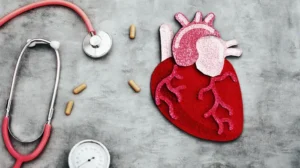Perimenopause, a transitional phase before menopause, brings with it a myriad of changes and challenges for women. Among these is an often-overlooked condition: tachycardia, or a rapid heart rate. Understanding how perimenopause can influence your heart health is crucial in managing symptoms effectively. This blog aims to shed light on tachycardia during perimenopause, offering insights into its causes, and various perimenopause tachycardia treatment options.
Contents
Can Perimenopause Cause Tachycardia?
 Yes, perimenopause can cause tachycardia. It is a condition characterized by a heart rate that’s faster than normal. The hormonal fluctuations associated with perimenopause can have several effects on the cardiovascular system, including:
Yes, perimenopause can cause tachycardia. It is a condition characterized by a heart rate that’s faster than normal. The hormonal fluctuations associated with perimenopause can have several effects on the cardiovascular system, including:
- Altered Heart Rate: Changes in estrogen levels can affect the autonomic nervous system, which regulates heart rate. This can lead to episodes of rapid heartbeat or palpitations.
- Increased Stress Response: Hormonal fluctuations can enhance the body’s response to stress, potentially leading to an increased heart rate.
- Impact on Blood Vessels: Estrogen has a role in maintaining the flexibility of blood vessels. As estrogen levels fluctuate and eventually decrease, this can affect blood flow and pressure, potentially causing the heart to beat faster to compensate.
- Electrolyte Imbalances: Hormonal changes can also affect electrolyte levels in the body. These are crucial for heart function. Imbalances can contribute to heart rhythm irregularities, including tachycardia.
It’s important to note that while tachycardia is a possible symptom during perimenopause, it’s not experienced by all women and can vary in intensity. Additionally, tachycardia can be a symptom of other underlying conditions. So it’s important for individuals experiencing a rapid heart rate to consult with a healthcare provider to determine the cause and appropriate treatment.
Medical Approaches In Perimenopause Tachycardia Treatment
When addressing tachycardia in the context of perimenopause, medical approaches aim to manage both the symptoms and the underlying hormonal fluctuations. Here are some common medical strategies used in perimenopause tachycardia treatment:
Hormone Therapy (HRT)
The primary goal of HRT is to replenish the declining levels of estrogen and progesterone. This can stabilize the body’s hormonal fluctuations. By restoring these hormones to a more balanced state, HRT can potentially alleviate heart palpitations and rapid heart rate. However, it’s important to approach HRT with caution, as it’s not suitable for everyone. Factors like personal health history, the risk of breast cancer, heart disease, and blood clots, are crucial considerations.
Beta-Blockers
Beta-blockers are a class of drugs commonly used to manage tachycardia. They work by blocking the effects of adrenaline on the heart, leading to a slower heart rate and reduced force of heart contractions. This makes them particularly effective in situations where tachycardia is stress-related or exacerbated by anxiety, a common occurrence during perimenopause due to hormonal changes. Beta-blockers can not only help in regulating heart rate but also in reducing the physical symptoms of anxiety, such as trembling and sweating.
Calcium Channel Blockers
 These medications help in managing tachycardia by relaxing the muscles of the heart and blood vessels. By doing so, they reduce the heart’s workload and lower blood pressure. This can be beneficial in cases where tachycardia is accompanied by hypertension. Calcium channel blockers are effective in controlling the rate of the heart, especially in atrial fibrillation, a common type of irregular heartbeat. They can be a preferred choice for patients who might not be able to take beta-blockers due to certain contraindications.
These medications help in managing tachycardia by relaxing the muscles of the heart and blood vessels. By doing so, they reduce the heart’s workload and lower blood pressure. This can be beneficial in cases where tachycardia is accompanied by hypertension. Calcium channel blockers are effective in controlling the rate of the heart, especially in atrial fibrillation, a common type of irregular heartbeat. They can be a preferred choice for patients who might not be able to take beta-blockers due to certain contraindications.
Antiarrhythmic Medications
When tachycardia is associated with arrhythmias (irregular heartbeats), antiarrhythmic drugs may be prescribed. These medications work by correcting abnormal electrical impulses in the heart, thereby normalizing the heartbeat. The choice of antiarrhythmic medication depends on the type of arrhythmia, the overall health of the patient, and other individual factors. These drugs can be very effective, but they require careful monitoring due to potential side effects and the risk of provoking other types of arrhythmias.
Electrophysiological Testing and Treatment
In cases where tachycardia is persistent and concerning, electrophysiological studies (EPS) may be recommended. EPS is a specialized test that examines the electrical activity and pathways of the heart, offering detailed insights into the nature of arrhythmias. This procedure can help pinpoint the specific areas of heart tissue that are causing irregular heartbeats, allowing for targeted treatments. One such treatment is cardiac ablation, a procedure that carefully destroys the tiny areas of heart tissue responsible for the erratic electrical signals.
Supplements and Nutritional Support
Alongside conventional medical treatments, some healthcare providers may suggest nutritional support and supplements to help manage tachycardia. Magnesium, for instance, is a mineral known for its role in maintaining normal nerve and muscle function, and its adequate levels can support heart health. Omega-3 fatty acids, often found in fish oil supplements, are also considered beneficial for heart health, potentially aiding in the regulation of heart rhythm. It’s important, however, to approach the use of supplements with care.
Overall, perimenopause tachycardia treatment is a combination of regular medical monitoring, specialized treatments for complex cases, and supportive lifestyle and dietary changes that can be highly effective. These approaches need to be personalized and adjusted over time. Ultimately, taking into account the unique needs and health status of each individual.
Immediate Strategies To Help In Perimenopause Tachycardia
 For immediate relief and management of tachycardia during perimenopause, several strategies can be employed. These methods are designed to provide quick relief from symptoms and can be particularly useful in managing sudden episodes of rapid heart rate:
For immediate relief and management of tachycardia during perimenopause, several strategies can be employed. These methods are designed to provide quick relief from symptoms and can be particularly useful in managing sudden episodes of rapid heart rate:
Deep Breathing and Relaxation Techniques
Practicing deep breathing exercises can help calm the nervous system and reduce heart rate. Techniques like diaphragmatic breathing, guided imagery, or progressive muscle relaxation can be particularly effective. These methods not only help in the immediate moment but also contribute to long-term stress management, which is beneficial for heart health.
Vagal Maneuvers
Certain actions, known as vagal maneuvers, can stimulate the vagus nerve and potentially slow down the heart rate. This includes methods like the Valsalva maneuver (exhaling forcefully with a closed mouth and nose), coughing, or splashing cold water on the face. These techniques can sometimes help reset the heart rhythm to a normal pace.
Staying Hydrated
Dehydration can contribute to an increased heart rate. Drinking water and staying well-hydrated can help in managing tachycardia. It’s especially important to maintain hydration if you’re experiencing other perimenopausal symptoms like sweating or hot flashes.
Limiting Stimulants
Caffeine, nicotine, and certain over-the-counter medications like decongestants can exacerbate tachycardia. Reducing or avoiding these stimulants can provide immediate relief from rapid heart rate episodes.
Mindfulness and Meditation
Engaging in mindfulness practices or meditation can be a quick way to center yourself and reduce stress. This, in turn, can help lower your heart rate. Even a few minutes of meditation can have a calming effect on the heart.
Positional Changes
Sometimes, simply changing your position can help manage tachycardia. If you experience a rapid heartbeat while lying down, try sitting or standing up slowly. Conversely, if you’re standing when tachycardia strikes, try sitting or lying down with your legs elevated.
Avoiding Heavy Meals
Large or heavy meals, especially those high in carbohydrates or sugars, can increase heart rate as the body works harder to digest the food. Eating smaller, more frequent meals can help avoid this trigger.
Monitoring Symptoms
Keeping a symptom diary can be an immediate strategy to understand what triggers your tachycardia. Noting down when it occurs, under what circumstances, and any associated activities or foods can help in identifying patterns and managing them more effectively.
While these strategies can provide immediate relief, they are not a substitute for professional medical advice or treatment. If tachycardia persists, is severe, or is accompanied by other symptoms like chest pain, shortness of breath, or fainting, it’s crucial to seek medical attention promptly.
What Vitamins Stop Heart Palpitations?
 While vitamins and supplements can play a role in overall heart health, it’s important to understand that they are not a cure-all for heart palpitations. However, certain vitamins and minerals can help support heart function and potentially reduce the occurrence of palpitations. Here are some key nutrients that are often associated with heart health:
While vitamins and supplements can play a role in overall heart health, it’s important to understand that they are not a cure-all for heart palpitations. However, certain vitamins and minerals can help support heart function and potentially reduce the occurrence of palpitations. Here are some key nutrients that are often associated with heart health:
- Potassium
This mineral is essential for maintaining normal heart function and a balanced electrolyte status. Low levels of potassium can contribute to heart palpitations and arrhythmias. Potassium-rich foods include bananas, oranges, cantaloupe, spinach, and potatoes.
- Calcium
Calcium plays a role in muscle contraction, including the heart muscle. Ensuring adequate calcium intake is important, but a balance between calcium and other minerals like magnesium and potassium is crucial for heart health. Dairy products, fortified plant milks, leafy green vegetables, and almonds are good sources of calcium.
- Vitamin D
There is some evidence that Vitamin D plays a role in heart health and a deficiency might be linked to an increased risk of cardiovascular issues. Sun exposure is a primary source of Vitamin D. But it can also be found in fatty fish, fortified foods, and supplements.
- B Vitamins
Specifically, vitamins B9 (folate), B6, and B12 have been linked to heart health. They help control levels of homocysteine in the blood, a type of amino acid that at high levels, is linked to an increased risk of heart disease.
It’s important to remember that while these vitamins and minerals can support heart health, they should not be used as a standalone treatment for heart palpitations or other heart-related conditions. Hence, it’s essential to consult with a healthcare provider for a proper diagnosis and treatment plan.
Conclusion
In conclusion, perimenopause tachycardia treatment involves understanding the changes your body is going through and finding effective ways to manage your symptoms. From exploring medical treatments like hormone therapy and beta-blockers to adopting lifestyle changes, there are various strategies to help you maintain a healthy heart. Remember, supplements like magnesium or omega-3 fatty acids can support heart health, but they should be used under medical guidance.
Regular check-ups are crucial for monitoring your heart’s health. And it’s important to seek immediate medical attention if you experience severe or persistent symptoms. Above all, listen to your body and work closely with your healthcare provider to find the best approach for you. If you are facing menopause-related issues, menopause treatment at HerMantra can help. Book your free trial online menopause treatment session now.


